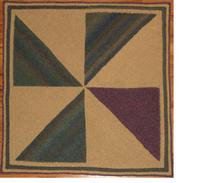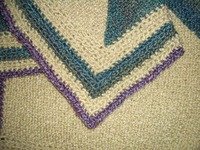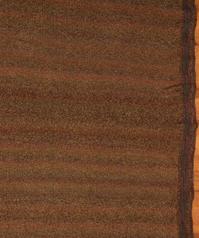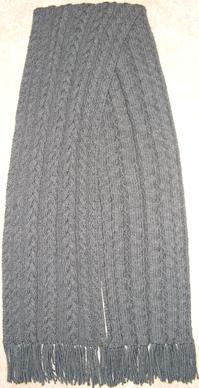 After I admired it, a friend of my SO's family gave me a lovely crocheted large doily (or small tablecloth) for a round side table.
After I admired it, a friend of my SO's family gave me a lovely crocheted large doily (or small tablecloth) for a round side table. It's a pretty piece, though not something that has a place in our house, given our current decor. In return, I wanted to give her something handmade. Since she's not a knitter, I wanted to knit something for her.
I bought some cotton yarn to make potholders, but that didn't end well. They were too stiff and the cream, beige, and green of the yarn didn't show off the knitting to the extent I wanted. The potholders were too simple and just not worthy of her. I gave up on them and I'll repurpose the yarn into some thing else later.
In the local yarn store, I saw a dark grey superwash (non-felting) Merino wool in the same brand I'd used before to knit a scarf in red. I ordinarily wouldn't make something out of wool for a gift, but this wool is machine washable which makes me feel a little better about it. Also, my SO assured me that the recipient of this particular gift would have no problem hand-washing a scarf if she needed to.
The finished product is about 6 1/2" wide and 57" long, excluding 3" of fringe on either end. I usually don't add fringe to scarves since it gets ratty and messy pretty easily, but the edge of this scarf needed it to visually smooth out the wavy edges of the cables. It took me about an hour to add the fringe and I think the result is well worth the time. If (when) I make this scarf again, I'll add a couple of rows of crochet to the short edges to further smooth the transition between the cables and the fringe.
I'm quite pleased with the way it came out and I hope she enjoys it.
Note to self: never admire anything aloud.
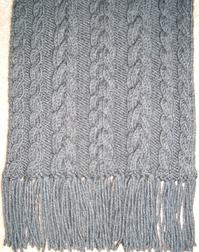
Materials:
5 - 50g (1.75oz.) skeins Zara Merino yarn (gray - color 1468)
size 4 (3.5 mm) knitting needles
size E (3.5 mm) crochet hook for easy bind off and fringe application (optional)
1 skein of yarn for fringe (optional)
Stitches:
C4(6)B = Slip next 2(3) sts onto cable needle and hold at back of work, K2(3), then K2(3) from cable needle.
C4(6)F = Slip next 2(3) sts onto cable needle and hold at front of work, K2(3), then K2(3) from cable needle.
Instructions:
Cast on 70 sts.
Row 1 (Right Side): P2, K4, P3, K4, P4, K9, P5, K8, P5, K9, P4, K4, P3, K4, P2.
Row 2 and all even rows:
Row 3: P2, K4, P3, K4, P4, C6F, K3, P5, K8, P5, C6F, K3, P4, K4, P3, K4, P2.
Row 5: P2, C4F, P3, C4F, P4, K9, P5, C4F, C4B, P5, K9, P4, C4B, P3, C4B, P2.
Row 7: P2, K4, P3, K4, P4, K3, C6B, K3, P5, K8, P5, K3, C6B, P4, K4, P3, K4, P2.
Row 9: Repeat Row 1.
Row 11: P2, C4F, P3, C4F, P4, C6F, K3, P5, C4F, C4B, P5, C6F, K3, P4, C4B, P3, C4B, P2.
Row 13: Repeat Row 1.
Row 15: Repeat Row 7.
Row 17: Repeat Row 5.
Row 19: Repeat Row 3.
Row 21: Repeat Row 1.
Row 23: P2, C4F, P3, C4F, P4, K3, C6B, P5, C4F, C4B, P5, K3, C6B, P4, C4B, P3, C4B, P2.
Row 24: Repeat Row 2.
Repeat Rows 1-24 until approximately 57" from beginning (or your desired length).
Finishing:
Bind off.
Weave in all ends.
Optional fringe:
- Wrap the yarn around a piece of sturdy cardboard cut to the desired finished length of your fringe. (Don't wrap too tightly, as the suggested yarn will stretch.)
- Cut along one edge of the cardboard to yield pieces twice the length of your cardboard's width.
- Starting at a corner of the short end of the scarf, insert the crochet hook from back to front.
- Fold two strands of your fringe yarn in half and pull the loops through the scarf.
- Insert the ends of the fringe yarn through the loops (forming a lark's head knot) and pull tight.
- Repeat for every other stitch along both short ends of the scarf.
